
Just How Dangerous Are 3D Printed Guns?


At 3DSourced we’ve covered everything 3D printing and 3D since 2017. Our team has interviewed the most innovative 3D printing experts, tested and reviewed more than 20 of the most popular 3D printers and 3D scanners to give our honest recommendations, and written more than 500 3D printing guides over the last 5 years.
3D printed guns have been a subject of controversy and intense scrutiny ever since they were first conceptualized. People feared that anyone could now easily print plastic serial number-devoid “Ghost Guns,” leaving zero trace at crime scenes and spurring a new wave of criminal enterprise.
Whereas making improvised firearms once required a measure of expertise, suddenly, anybody could make a lethal, untraceable, and indetectable weapon on a $200 3D printer, all from the privacy of their own home.
However, seven years later fear has waned, with only one unconfirmed report of a murder using a 3D printed gun.
This was not due to the technology’s stagnation. Instead, despite continuous legal challenges and it’s outlawing across much of the Western world, 3D printed guns are more lethal and prolific today than they have ever been.
So, what place do 3D printed guns have in the world today?
The Controversial Beginnings of 3D Printed Guns
The first 3D printed guns were almost entirely made of plastic, with the only non-plastic elements being the ammunition and a metal firing pin.
This period’s most famous gun was Defense Distributed’s “Liberator” pistol. It became famous not only because it was the world’s first example of a working 3D printed gun, but also because Defense Distributed released the weapon’s files and building instructions online.
Suddenly, anybody with a 3D printer could bypass all forms of legal screening, and simply print their own weapons from home. These types of homemade and unregistered weapons became known as “Ghost Guns,” due to their existence being unrecorded by the government.
The Liberator could bypass metal detectors and therefore undermine existing security infrastructure, prompting intense media scrutiny at the time. Infamously, two journalists from the Israeli Channel 10 filmed themselves smuggling the pistol into the Israeli Parliament, and then into a room with Prime Minister Benjamin Netanyahu. Suddenly, no one was safe.Chanell 10 documented their Israeli Parliment Stunt
A Legal History
Defense Distributed were ordered to remove the files by the Bureau of Alcohol, Tobacco, Firearms and Explosives (ATF). Although the ATF cited arms regulations, the weakness of their stance caused speculation; chiefly, that this was a reactionary move from a government that already feared conventional ghost guns, and were just trying to bury the files as quickly as possible.
Although Defence Distributed would bow to the ATF and remove their files, its legal battles were far from over. They immediately filed a constitutional challenge against the ATF that was only settled in 2018, and later became embroiled in other smaller lawsuits that continue into 2020.
Throughout these legal skirmishes the Liberator’s plans and files continued to circulate online through alternative file-sharing websites. They were easily accessible to anyone with an internet connection, despite the government’s best efforts.
In 2018 Defense Distributed reached a settlement, allowing them to resume hosting the 3D printed gun files online, through its companion website DEFCAD. 3D printed gun files were already circulating online, allowing them to relaunch to an established community of gunmakers who had been printing, sharing, and improving plastic gun designs since 2013.
How easy is it to 3D print a gun?
The only equipment an end-user needs to print a gun is an internet connection, a 3D printer, and filament.
Price, a former limiting factor, is no longer a concern. In 2013, industrial 3D printers were needed to reliably produce 3D printed guns; however, entry-level 3D printers can now produce these firearms.
Various “Getting started” guides now exist online, produced by the 3D printed gun community. A prominent content creator, known under the pseudonym CTRL+Pew, released an updated 2020 guide, recommending the Ender 3 Pro, a 3D printer under $300 inclusive of filament and add-ons.
Considering that legally purchasing a new Glock 19 handgun can easily cost over $500, 3D printing your guns is comparatively a bargain.
This ease of access prompted much of the fear first leveled at 3D printed guns, especially because despite being made almost entirely of plastic, these guns still fire live ammunition and can absolutely kill or maim their targets.
Despite this however, they have proven to be less than effective weapons.
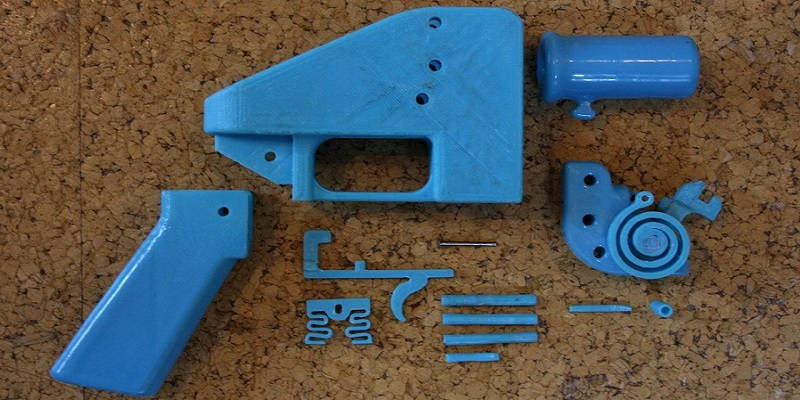
How lethal are plastic 3D printed guns?
Outside of personal skill, a firearm’s effectiveness depends on its reliability, accuracy, rate of fire, and power. As plastic guns use conventional ammunition, they have never suffered from low power.
However, poor overall performance could explain why plastic guns aren’t used in violent crime.
Reliability & Danger to User
Despite making them unprecedentedly accessible, their plastic construction also plagues reliability. Plastics struggle with the pressures of live ammunition, and often misfire, break, or explode in the user’s hand.
When the Liberator was released, it rarely survived more than 10 shots before exploding, with even Defence Distributed’s own prints recorded exploding on the eleventh. In the 7 years since, reliability has improved but remains a significant issue.
This explosive risk also creates safety concerns, both for the shooter and bystanders. After two UK newspapers asked him to print pistols, Jonathan Rowley, design director of 3D printing specialists Digits2Widgets, responded with this warning:
“Do not attempt to load and fire a 3D printed gun in which any element has been printed on a home 3D printer… We fear that the next story will be about a child blowing their hand off while experimenting with a 3D printed gun … This type of accident is the immediate danger of the project and will happen long before anyone is deliberately killed by one of these tools.”Jonathan Rowley
Practically, this means that when a user points a 3D printed gun at someone, they can’t be confident that a bullet will exit the other side with every trigger-pull, or whether they’ll blow their own fingers off.An explosive test-firing of a Liberator-style pistol
Accuracy
Reliability issues also affect accuracy. With their components being so fragile, it is difficult to print reliable long-barrelled or rifled guns. Their barrels often either warp or shatter from the heat of shooting
Additionally, fragility has made attaching sights to these weapons difficult, forcing most to go without. This reduces the accurate firing range of a 3D printed gun to either very close, or point-blank.
Rate of Fire
Fragility again prevents plastic guns from achieving automatic fire, with their components having to be simple to survive firing live ammunition. The Liberator and its contemporaries are all single-shot weapons (must be reloaded after each shot) but more modern 3D printed gun designs more closely resemble revolvers or pepperboxes, with rotating chambers or barrels respectively, allowing the user to fire multiple bullets between reloads.
The rise of revolving 3D printed guns also raises their potential lethality. Using a revolving gun, an individual can wound multiple people today in the same time it would have taken them to wound one person in 2013.
These guns were present in Britain’s first 3D printed gun related conviction. In 2019, a police raid uncovered revolver-style 3D printed guns in a students’ central-London home.
The two weapons the student was found with were the PM522 Washbear, and Reprringer pepperbox. Both are popular 3D printed guns and are easily accessible online today.
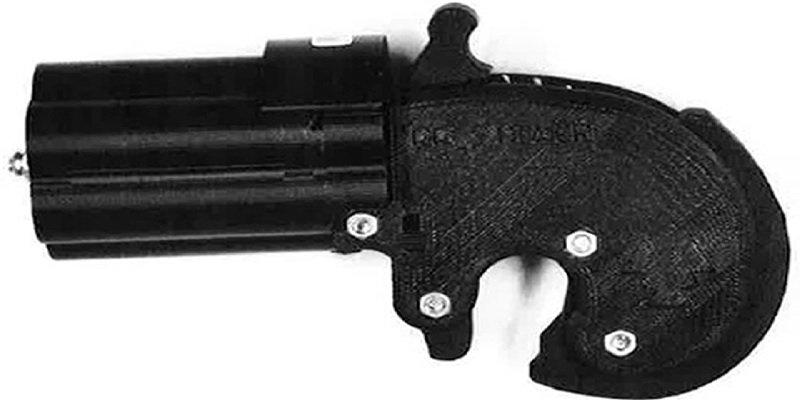
Despite these advances, fully plastic 3D printed guns are still inaccurate, slow-firing, and incredibly unreliable. However, their lethality is not the only reason they are feared, the other being their undetectability.
Are plastic 3D printed guns undetectable?
Plastic 3D printed guns have raised security concerns since their inception. Being plastic means they can circumvent traditional weapon detection strategies, making them harder to trace in connection to crime.
Metal Detectors
Plastic does not set off metal-detectors, prompting concerns that plastic guns could be smuggled into airports and government buildings.
Soon after the Liberator pistol’s first successful test-firing, the then Congressman Steve Israel was interviewed on CNN to discuss legislation that would restrict the weapons:
“As we’ve just seen from that video, metal detectors may be obsolete technology now that you can make a plastic gun and bring it on a plane.”Congressman Steve Israel
The law in question passed – the Undetectable Firearms Act 2013 – forcing 3D printed guns to be designed with metal components.
However, these weapons could function perfectly without the included metal parts, meaning that end users could simply not install them without consequence.
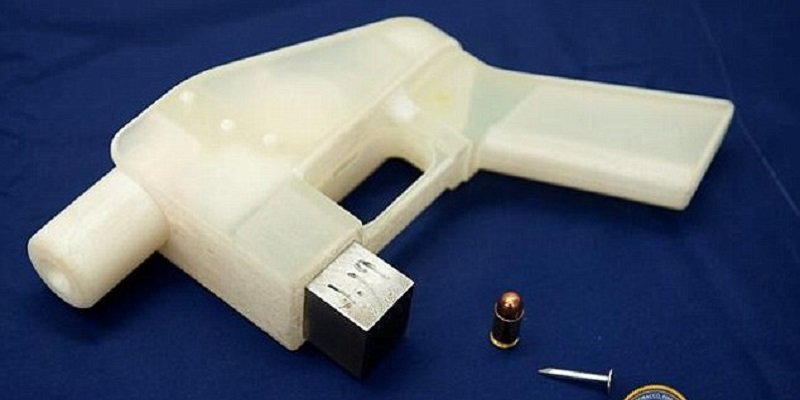
Despite the legislation, whether or not fully-plastic guns will fool a metal detector is debatable. Despite their plastic construction, a metal firing pin and live ammunition are both required to function as weapons. Both of these can trigger metal detectors depending on the metal used, size, and metal detector settings.
Even when Channel 10 smuggled a Liberator into the Israeli parliament, they did so without the barrel (because it blew off during a test-firing) or ammunition, essentially turning the weapon into a harmless prop. This casts doubt as to whether their stunt would have been detected if they had used metal parts.
In practice, this means that while some plastic guns won’t trigger metal detectors, others will, much in the same way that some metal medical implants will trigger airport detectors, while others will not.
Physical searches
Conventional and plastic firearms will both be detected by physical searches. Pat downs, luggage searches, and x-rays will all detect these weapons. However, plastic 3D printed guns can be disguised so they do not look like a conventional weapon.
This is especially true of the early generation of 3D printed guns, as they had to be large, simple, and overbuilt to withstand the pressures of firing live ammunition. For example, when disassembled, the Liberator looks more like a pile of PVC tubing than a weapon. At worst, it looks like a children’s water gun.
This presents better disguising opportunities for plastic 3D printed guns than than metal ones, as for example the bright blue and barrel-less Liberator used by Channel 10 in Israel better resembled a stapler than a 9mm handgun. However, this doesn’t make concealing ammunition any easier, potentially explaining why they didn’t use any for their stunt.
Detecting these disguised weapons will require further training of security personnel to identify dismantled plastic guns. However, in reality the concept of disguised weapons is not new.
Since World War II, disguised weapons have been engineered by both individuals and world-nations, with famous designs including cigarette-guns, ring-guns, pen-guns, mobile phone guns, and perhaps most famously, the “Sedgley Glove Gun,” featured in Quentin Tarantino’s 2009 film Inglorious Basterds. So, whether any new or special security adjustments would be needed is unclear.
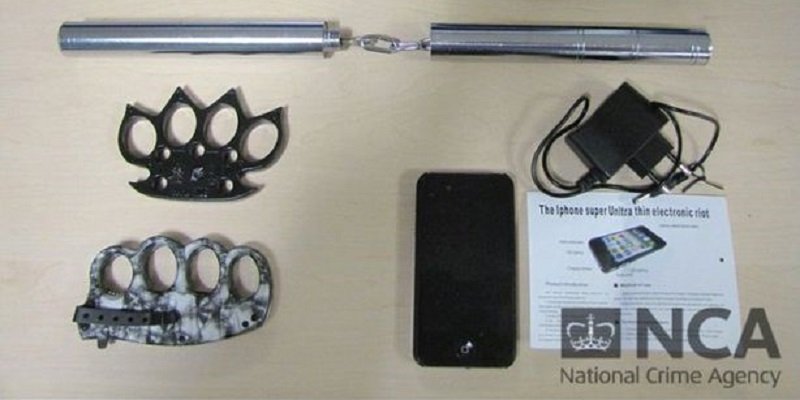
Untraceable Crime Scenes
3D printed guns, along with all ghost guns, have no serial numbers or registration.
Usually, when a weapon is recovered at a crime scene, these details are used to find the weapon’s owner, its production, and retail journey all the way until it was used in a crime.
Detailing their process, the ATF explains that:
“Firearms tracing begins when ATF or another law enforcement agency discovers a firearm at a crime scene and wants to learn where it came from… This trace information can identify possible suspects or traffickers and link them to specific firearms found in criminal investigations. Tracing can also help detect domestic and international trafficking patterns and identify local trends in the sources and types of crime guns.”
Without these serial numbers, tracing the offending weapon’s history becomes harder. These traditional tracing systems can’t be used, restricting law enforcement to using conventional forensics and investigative techniques.
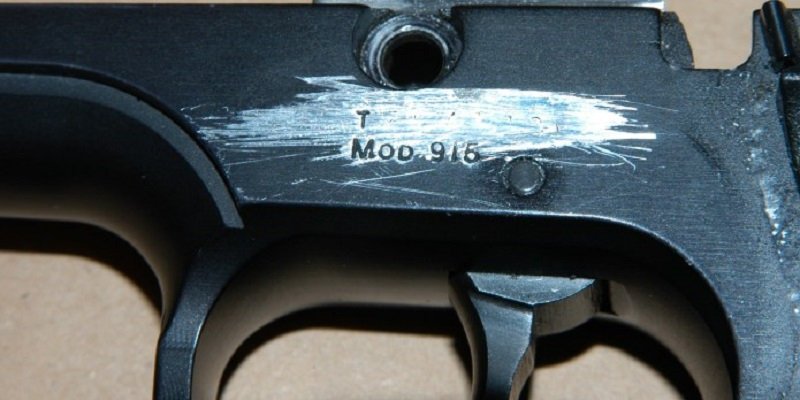
Are plastic 3D printed guns really a threat?
Fully plastic guns pose a rising threat, but are currently no so than any other improvised weapon.
They are easy to obtain and fire live ammunition, but are unreliable and dangerous to the user.
They are harder to detect and trace than metal firearms, but still cannot be described as “undetectable.”
However, alternative metal designs are proving increasingly popular, and are far more reliable and dangerous.
Gun Kits and Multi-Material 3D Printed Guns
Instead of printing an entire gun on a 3D printer, an increasingly popular approach is to 3D print some of the weapon’s components, and install the rest using real weapon parts. The resulting multi-material guns overcome many of the issues associated with fully plastic guns.
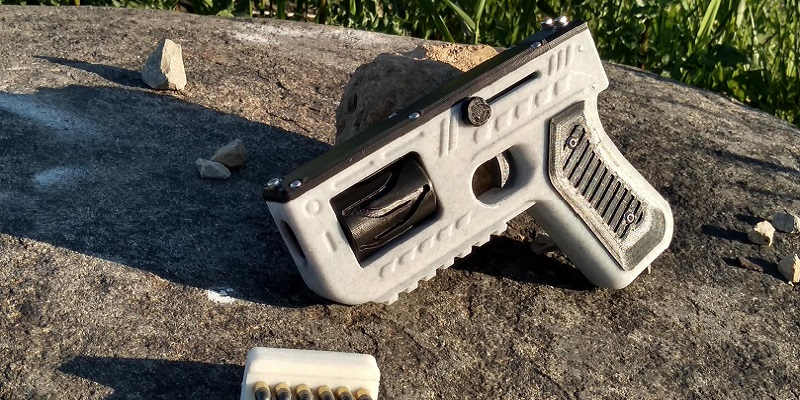
Metal Over Plastic?
The inclusion of metal components allows these weapons to be bigger, faster-firing, more accurate, and most significantly, more reliable.
Plastic 3D printed guns’ fragility prevented them from being long-barreled or rifled, relegating them to being little bigger than pistols. In comparison, by using metal components multi-material guns can be full-sized rifles, and the metal barrels won’t warp or shatter when fired. Using these metal rails also allows legitimate weapon attachments to be added onto these guns.
The results are weapons with more accuracy, owing to their longer barrels, and the option to use attached sights.
Additionally, the ability to use metal receivers and other action components has increased reliability, with the weapons less prone to jamming, misfiring, exploding, or otherwise failing to send bullets out of the barrel.
Well-made and modern weapons have been observed discharging more than 100 rounds without the plastic components failing. To put that into context, the Sandy Hook shooting, currently the US’s fourth deadliest shooting incident, used 156 rounds of ammunition.
Additionally, being able to use more complex components allows for both semi-automatic and fully automatic fire modes, though automatic fire significantly increases the chances of failure.
Or Plastic Over Metal?
Creating these metal 3D printed guns requires more skills and time investment.
One of the more prominent modern builders of reliable multi-material guns runs a website and YouTube channel under the name “Hoffman Tactical.”
In October 2020, he released footage of himself shooting over 100 rounds through an AR15 rifle with a 3D printed receiver. He documented the trial and error process of making the weapon, revealing that it took over 3 months of refinement before his gun was able to withstand that many shots without failing.
Though more effective than $10 plastic 3D printed guns, these guns take months to make and can cost hundreds of dollars.Hoffman Tactical shooting over 100 rounds through his AR15 rifle.
Are Multi-Material 3D Printed Guns a Security Threat?
Like plastic guns, the most concerning feature about multi-material guns is the technology’s ability to produce “Ghost Guns.” Though, they go about this in a slightly different way.
In the US, a gun’s receiver has a serial number and is documented. Any part except the receiver can be purchased without any form of screening or registration.
Even before the rise of 3D printing, “gun kits,” that contain everything needed to make a firearm minus a receiver, have been readily available. The user then either makes their own receiver, or purchases an incomplete “80%” receiver and finishes the work.
3D printing’s involvement has made this process more accessible, lowering the skills required to print these receivers, and ultimately allowing anybody to make an unregistered, 100-plus round capable gun.
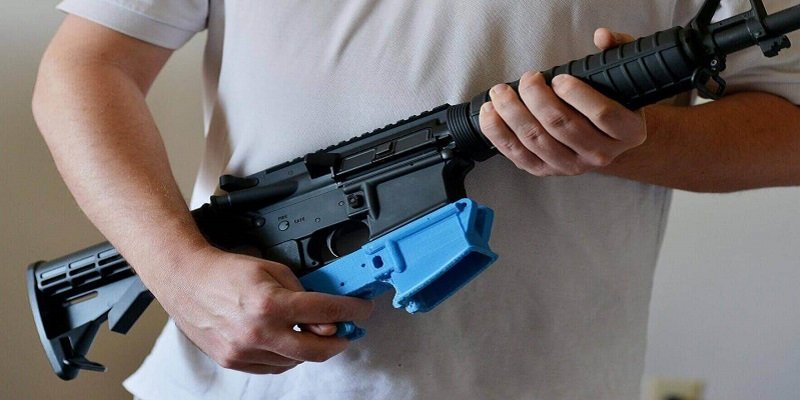
How Dangerous are Multi-Material Guns?
Multi-material guns are significantly more effective weapons than plastic guns on all fronts, but are still dismissed as being too unreliable when compared to other improvised weapons. They still fail frequently, with users never entirely certain that a bullet will exit the barrel with each trigger pull.
Despite all of the advances 3D printing has brought to the homemade gun world, the future of homemade guns appears to lay not with 3D printing, but with another increasingly affordable technology that promises to address all of the current weapon’s shortcomings.
CNC Milled Guns
Computer numerical control (CNC) milling machines function in a similar fashion to 3D printing. CNC differs in that rather than adding layers of material to create an object, it instead removes material. In this case, CNC machines remove material from an aluminum workpiece to form the gun component.
The technology’s real value is its ability to produce metal firearm receivers. As mentioned above, manually finishing a receiver takes time and skill to complete accurately. While 3D printed receivers are proven to work well, they ultimately face reliability issues. CNC milled receivers solve both issues, with the end-user only needing to manually attach a gun kit’s components to an accurately and automatically milled metal receiver.
The resulting fully-metal gun is just as dangerous as standard guns, and can be made by someone without much CNC experience.
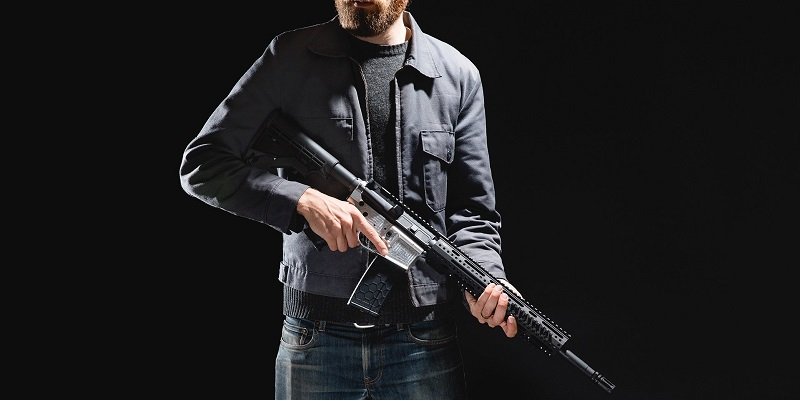
The barrier to entry was initially limited by cost, with CNC mills in 2013 capable of gun production costing thousands of dollars, rather than hundreds. However, efforts by Defense Distributed have seen even that barrier drop to an unprecedented low.
Ghost Gunner
The Ghost Gunner is a CNC machine designed by Defense Distributed specifically to make printing gun receivers cheap and easy. They are currently selling their third generation model, the Ghost Gunner 3, for $2,100. It is capable of milling various receivers ready to be assembled into weapons, including the AR-15 rifle, AR-308 rifle, and M1911 pistol.
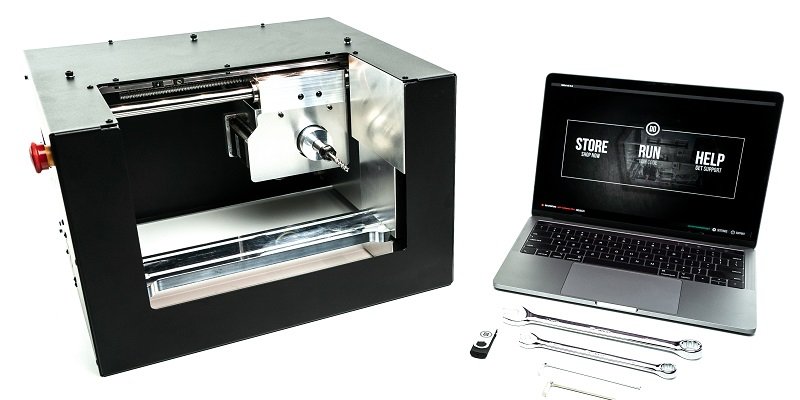
What place does 3D printed guns have in the world today?
The fear that 3D printing would be used by criminals to print lethal weapons was tempered in the face of the first generation of fragile and failure-prone pistols.
But the technology has quietly innovated over the past 7 years. Today, individuals can now affordably, quickly, privately, and with no existing skill, build a weapon that performs indiscernibly from one purchased legitimately. And all without any form of official screening – so long as they can legally buy gun kits.
Perhaps ironically, the concerns originally raised in 2013 have now become reality, though to far less fanfare.
I began this article by theorizing that a lack of involvement in crime caused the spotlight on these weapons to fade, with their place in the world seemingly playing second fiddle to more conventional homemade weapons.
However, with current 3D printed and CNC milled weapons performing so effectively, and the barrier to entry lower than ever, it would be far from surprising if that status quo soon changes.




















